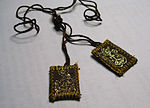Consecration of Russia to the Immaculate Heart of Mary

The Consecration of Russia to the Immaculate Heart of Mary is a belief in the Roman Catholic Church that a specific act of consecration on the part of the Pope has been required by the Virgin Mary, in return for which there would be world peace.
The Consecration of Russia is inherently related to the Marian apparitions reported at Our Lady of Fátima and Pontevedra, Portugal during which Portuguese children stated that the Virgin Mary appeared to them and delivered specific messages. The reported messages included a number of secrets that were gradually revealed by the Holy See. The messages emphasize the praying of the Rosary, wearing of the Brown Scapular, made a number of prophecies and promises, one of which was that through the Consecration of Russia peace would be achieved.
History and Background
The consecration of Russia was reportedly requested by the Virgin Mary, in a series of Marian apparitions known as Our Lady of Fátima, to three visionaries in 1917. It was also reported in further apparitions in 1925 in Pontevedra, Portugal to a single remaining Fatima visionary. The Fátima visionaries stated that the Virgin Mary promised:
"But in the end, My Immaculate Heart will triumph. The Holy Father (and the remaining bishops) will consecrate Russia to Me. Russia will be converted and a period of peace will be given to mankind."
In 1925 the Fátima visionary Lúcia Santos reported further Marian apparitions (known as the Pontevedra apparitions) and stated that the Virgin Mary of Fátima appeared to her again:[1]
"... It was Our Lady of Fátima... with a crown of thorns... and said to me: "The moment has come in which God asks the Holy Father in union with all the Bishops of the world to consecrate Russia to My Immaculate Heart, promising to save it by this means.""
Luca Santos stated that at Pontevedra the Virgin Mary revealed to her Mary's Peace Plan consisting of three elements:[2]
- Praying the Rosary and wearing the Brown Scapular, the Rosary and the Scapular being inseparable.
- Acts of Reparation for sins against God and the Immaculate Heart of Mary through First Saturdays devotion.
- A public ceremony in which the Pope and the Catholic bishops consecrate Russia to the Immaculate Heart of Mary.
Towards the end of December 1940, Lúcia Santos sent a letter to Pope Pius XII, disclosing for the first time part of the secret about Russia and urging him to consecrate Russia.[3]
Consecration in the Roman Catholic Church

Two popes consecrated Russia within the Roman Catholic Church based on the messages of Fátima and Pontevedra. One was Pope Pius XII, who was appointed Archbishop in the Sistine Chapel on May 13, 1917, the same day the Fátima apparitions were reported. The other was Pope John Paul II who was shot in Rome on May 13, 1981 and later credited Our Lady of Fátima with his recovery, saying that it was "in mysterious coincidence with the anniversary of the first apparition".[4][5]
In October 1942, Pope Pius XII performed the Consecration to the Immaculate Heart of Mary for the entire world and a decade later in July 1952 he specifically consecrated the Peoples of Russia to the Immmaculate Heart of Mary by his apostolic letter Sacro Vergente Anno. Pius XII stated:[6][7]
"Just as a few years ago We consecrated the entire human race to the Immaculate Heart of the Virgin Mary, Mother of God, so today We consecrate and in a most special manner We entrust all the peoples of Russia to this Immaculate Heart…"
On March 25, 1984, the feast of the Annunciation, Pope John Paul II consecrated Russia in a public ceremony. Lúcia Santos, one of the seers of the Fátima apparitions, said that the consecration requested by the Virgin Mary was fulfilled and accepted in heaven, and that everyone should live out the consecration personally by faithfully wearing the Brown Scapular.[8]
The entrance to the Sanctuary of Our Lady of Fatima, to the south of the rectory, is a segment of the Berlin Wall intended to emphasize the belief that the Rosary prayers influenced the fall of the Berlin Wall related to the Consecration of Russia based on the Our Lady of Fátima messages.[9]
Russian Orthodox objections
Members of the Russian Orthodox Church object to the concept of the Consecration of Russia for two reasons: (1) Russia has already been Christian for over one thousand years, and has a great devotion to the Theotokos, and (2) the concept contains what appears to be an implicit proselytism of Russian Orthodox Christians to the Roman Catholic faith. Orthodox apologists point out that Russia was still an Orthodox nation at the time, and was not yet under the control of the militant atheist Bolsheviks. Thus the phrase "Russia will be converted" can only imply conversion from Orthodoxy to Roman Catholicism.
Notes
- ^ Nicholas Perry, 1989, Under the Heel of Mary, Routledge Publishers ISBN 9780415012966 page 188
- ^ Lynette Marie Ordaz, 2008, The Real Mary, Authorhouse Books, ISBN 9781434343321 page 88
- ^ Nicholas Perry, page 190
- ^ Osservatore Romano Article on Fátima [1]
- ^ Garry Wills, Why I am a Catholic, Houghton Miflin Publishers ISBN 9780618380480 page 246
- ^ Acta Apostolicae Sedis 44, 1952, page 505
- ^ Vatican Website (the papal letter) [2]
- ^ Mark Miravalle, 1993, Introduction to Mary, ISBN 9781882972067 page 171
- ^ Regis St. Louis and Robert Landon, 2007, Portugal, Lonely Planet Press ISBN 9781740599184 page 290
The Consecration Of Russia can also be the blessing of a Temple. If Viewed from the Perspective that Our Body were to be considered Our Own Personal Temple . Thus, The Pope, Bishops, Priests, and all Humanity must Consecrate Russia to Mary's Immaculate Heart.
Sources
- Lúcia Santos, 1995, Fatima In Lucia's Own words, The Ravengate Press, ISBN 0911218106
- Thomas Petrisko, 1998, Fatima Prophecies, St. Andrews Press, ISBN 9781891903304
- Fatima Novena [3]

